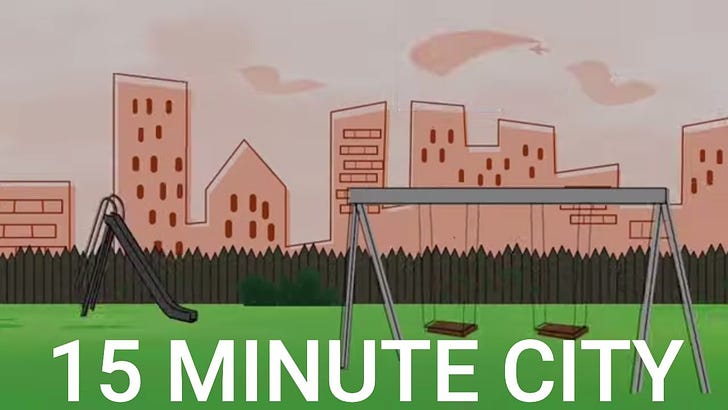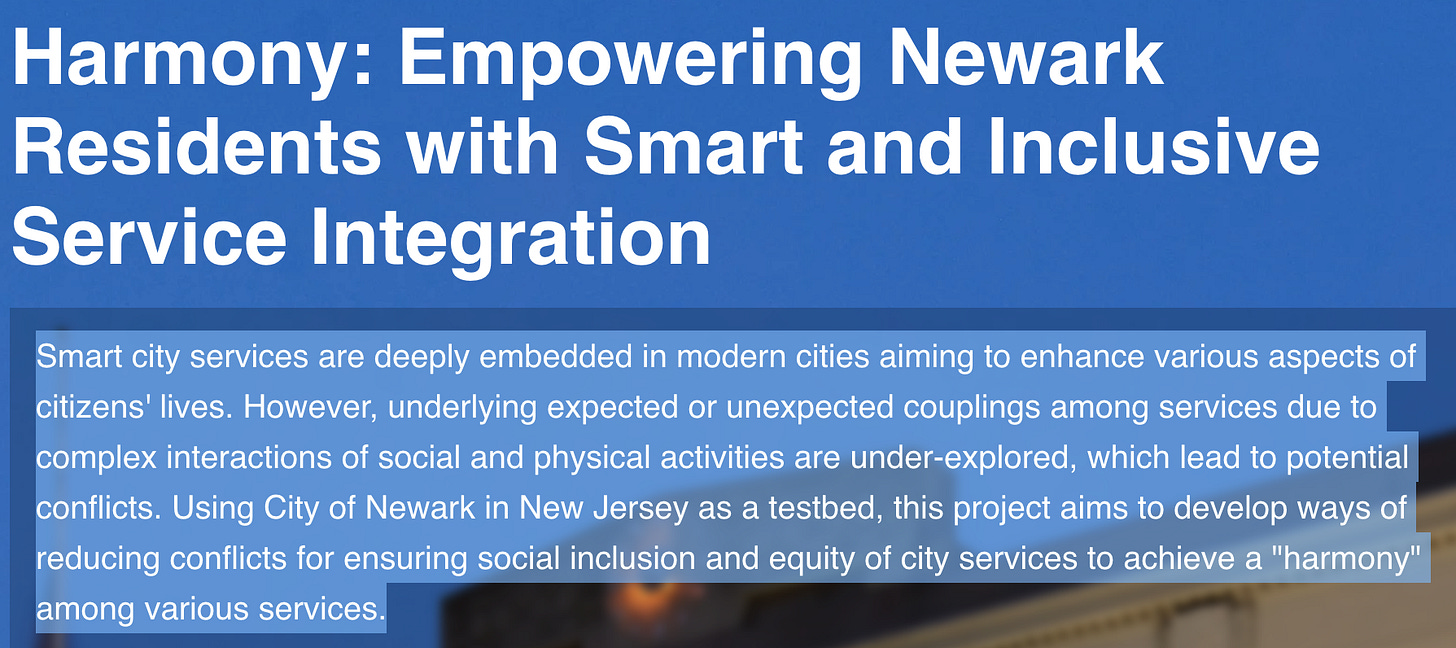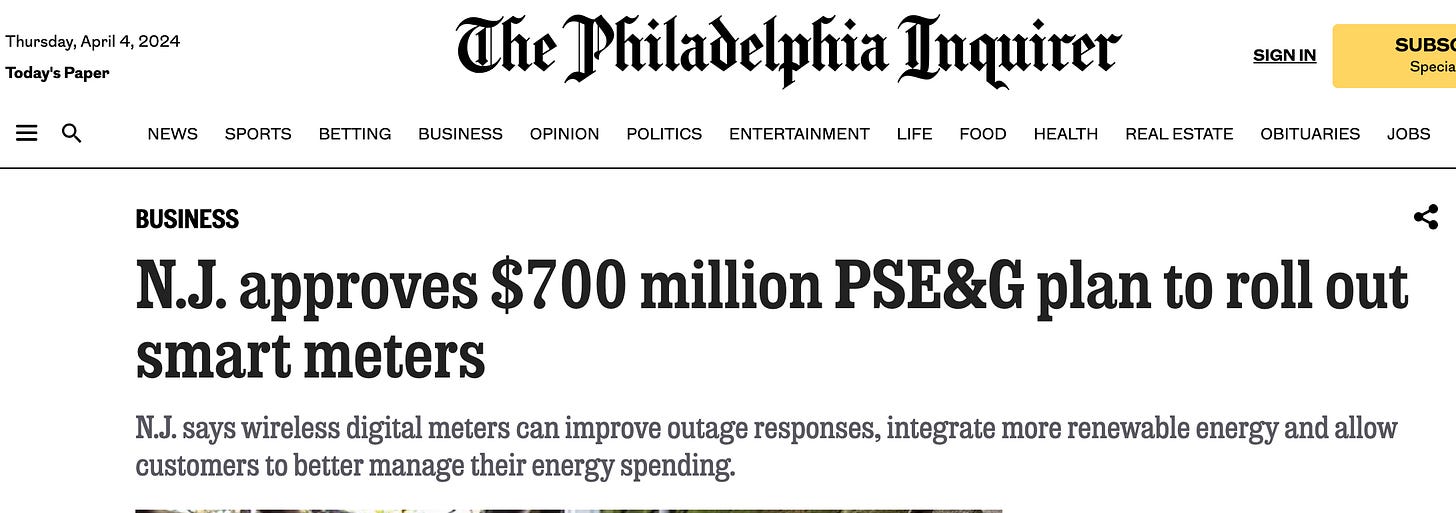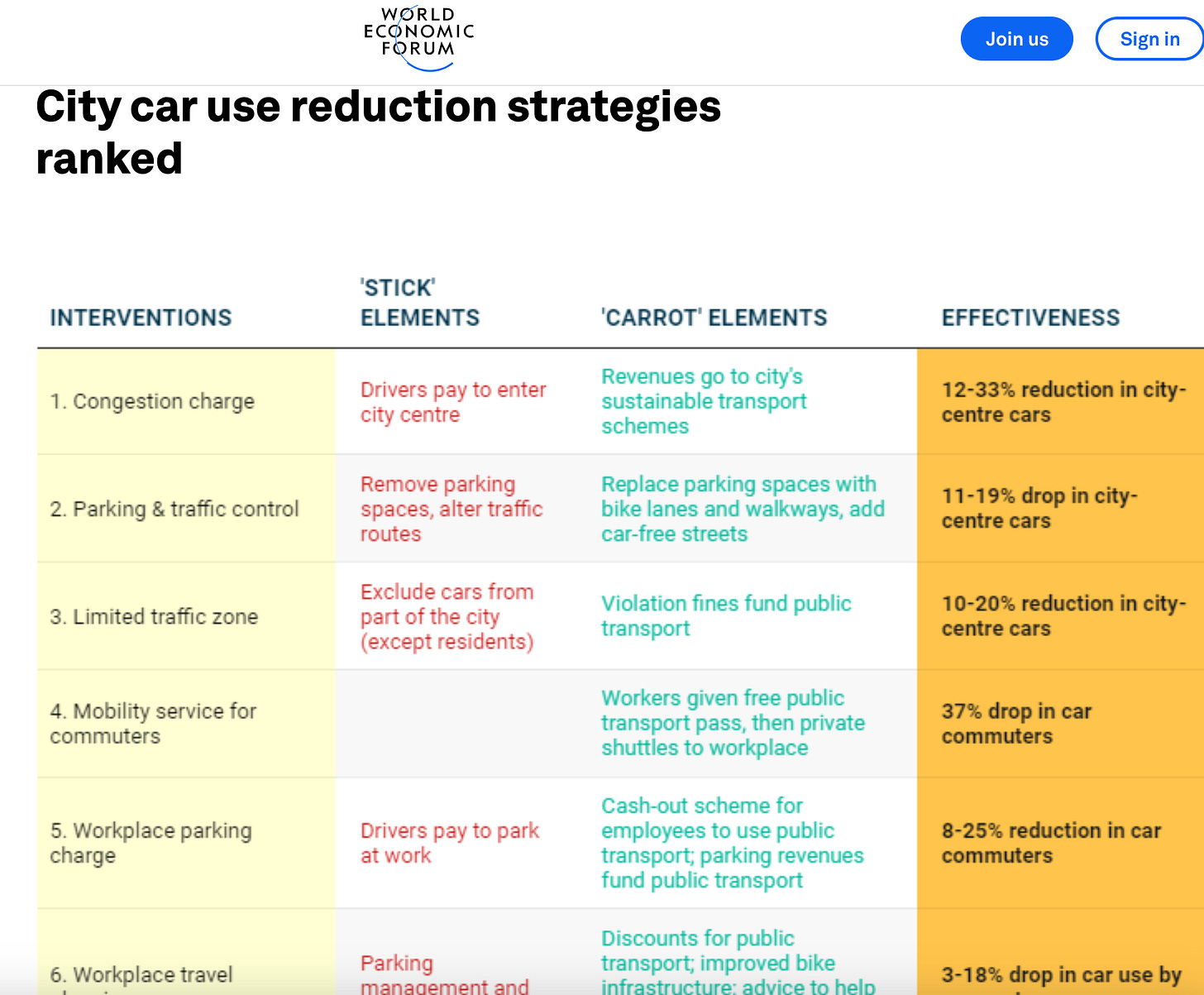New Jersey is trying to sell us on 15-minute cities. It’s time to start asking questions.
Their stated goal is to “create vibrant downtowns that are safe for walking and biking with accessibility to frequent public transit and reduce our reliance on cars.”
But as you watch bucket trucks deployed throughout your neighborhoods, putting up ever-taller phone poles that are doubling up power lines in service of “the grid”, consider what is really happening.
Because it’s not all just parks, bike lanes and convenience…
I’ve written about this before. I recommend you read more about this here.
Is Your Town Being Transformed into a "15 Minute City"?
A couple of weeks ago, people took to the streets of Oxford to protest 15 Minute Cities after the local government announced plans to create these WEF-inspired neighborhoods. 15 minute cities have been proposed as a convenient climate change solution.
Inroads to tyranny are being paved from all directions. These roads are decidedly “one way” and most of us aren’t meant to have cars to drive on them. Plans for 15-minute cities are expertly marketed, but it is imperative that we read between the lines.
Funding “Harmony”
Harmony is one of the new euphemisms for shuffling us all under a rainbow of tyranny. (Remember when the FDA created exceptions to informed consent in the name of “harmonizing” clinical research?)
To that end, Rutgers has received a $2.3 million Smart and Connected Communities Grant from the National Science Foundation “for developing strategies and tools to create inclusive and equitable digital public services.”
(Pro tip: when you hear “equitable digital public services”, think surveillance for all.)
Using City of Newark in New Jersey as a testbed, this project aims to develop ways of reducing conflicts for ensuring social inclusion and equity of city services to achieve a "harmony" among various services.
https://smartcities.rutgers.edu/
And NJ municipalities are getting points and gold stars for falling in line with “approved actions”. There’s even a Mayors Leadership Institute on Smart Cities.
Cities can now pull data from sensors on the roads and around the city to track air pollution, predict infrastructure failures and detect incidents. The pollution level sensors can help to better inform the mayoral decisions about the types of connected transportation technology the community needs. The ability to use the data to change how things operate throughout the community can then be shared with the state to help determine health risks from pollution, which can elevate the mayor’s reputation statewide.
https://www.smartcitiesdive.com/news/why-mayors-matter-to-smart-cities/522246/
All of this is framed as being in service to the community… as changes are imposed on our communities without our consent. Meanwhile, grants and incentives serve to get towns and institutions on board by recruiting them to launch initiatives and do research to justify the need for more smart city programs. All of this is by design as information obtained from research and monitoring will be used justify additional restrictions on public behavior.
The World Economic Forum, in collaboration with Deloitte, is already rolling out plans for the governance of smart cities. If you read Deloitte’s report Smart Cities and the Virtue of Value Capture, you’ll see the lucrative business plan behind 15-minute cities. From its title page:
Understanding the value that public sector investment can generate, and capturing a fair share of that value, can dramatically increase success for project funding and financing
Because smart cities are about value capture. And just capture in general.
Turning Citizens into “Smart” Useful Idiots
When everything’s “smart”, everything can be surveilled and automated remotely. Listen to Davos panel speaker Patricia Poppe describe how our own automated smart devices will be used to control our energy usage:
The state took a very aggressive action to send out an emergency text message to all the California cell phones, and instantaneously 25,000 megawatts came off the system… which reaffirmed a hypothesis that I have that demand management with modern technology can be automated. We shouldn’t have to send a text message… Californians responded because they’re good citizens, but what it says is that could be automated with smart devices, Wi-fi communicating devices, and electric vehicles as a power resource, a bi-directional power resource back to the grid would be even an additional resource that was what I would refer to as “anyways economics.” People have already purchased the electric vehicle. It’s an investment anyways. Get its full value by putting its power back to the grid. And all of that can be automated. Technology can enable that... We can now manage demand and have the right use as the right time. Not just conserve, not just use less, but instead smooth out the demand curve and have distributed variable resources it can deliver. It will happen and I’m very optimistic. *emphasis mine
So, we purchase the technology and they use it to monitor and control us. See how that works?
And it’s already happening.
https://www.bobvila.com/articles/power-company-control-thermostat/
The American Recovery and Reinvestment Act of 2009 provided the U.S. Department of Energy with $4.5 billion to modernize the electric grid. The largest initiative of the act is building the smart grid, which includes technology, tools, techniques, and energy storage to improve power grid performance across the country…
In simple terms, the smart grid allows for two-way communication so customers and utility companies can communicate with one another digitally. The smart grid uses a mix of controls, computers, automation, new technologies, and equipment that all work together with the electrical grid to determine a need and respond appropriately.
Think of it this way: During a heat wave, as temperatures soar and as air conditioners kick on, the smart grid will sense the increase in demand for power and make adjustments as needed to prevent outages.
This may help explain why NJ utility companies, JCP&L and PSE&G have been offering so many incentives to get smart meters into homes.
Jersey Central Power & Light (JCP&L), a subsidiary of FirstEnergy Corp. (NYSE: FE), is offering Google Nest thermostats for $1 to customers now through the end of the year to help residents across the Garden State take control of their energy use. The initiative, offered by all utilities statewide in conjunction with Google Nest, is designed to help lower energy bills for customers amid rising temperatures and inflation.
In fact, incentives are EVERYWHERE.
Public Service Electric and Gas Co. received approval Thursday to spend $700 million over four years to roll out smart meters for its 2.3 million customers, vaulting New Jersey’s largest utility into an modern age that it says will be more energy efficient and eco-friendly.
The New Jersey Board of Public Utilities approved the utility’s plans to install the digital wireless devices, which allow for two-way communication between customers and the utility’s network. The gadgets provide real-time meter readings and improved outage management. They also allow utilities to shut off or turn on a customer’s power with the flip of a switch at a central utility station. *emphasis mine
https://www.inquirer.com/business/nj-smart-meters-pseg-approval-renewable-energy-20210107.html
And since so much time, energy and resources have already been poured into this agenda, it’s no wonder that the collateral damage and inconvenient truths about the health impacts of this technology are being ignored and dismissed.
15-Minute Cites = 24/7 Surveillance
A 2021 article in Foreign Policy Magazine highlights additional concerns:
Whether they are in China or elsewhere, smart cities are usually described in benign terms with the soothing promise of greener energy solutions, lower-friction mobility, and safer streets. Yet in a growing number of places from New York to Hong Kong, there are growing concerns about the ways in which supercharged surveillance is encroaching on free speech, privacy, and data protection. But the truth is that facial recognition and related technologies are far from the most worrisome feature of smart cities.
Part of what supposedly makes cities smarter is the deployment and integration of surveillance technologies such as sensors and biometric data collection systems. Electronic, infrared, thermal, and lidar sensors form the basis of the smart grid, and they do everything from operating streetlights to optimizing parking and traffic flow to detecting crime.
WEF advisor Yuval Harari explains how invasive surveillance was always part of the plan:
Covid is critical because it this is what convinces people to accept, to legitimize, total biometric surveillance. We want to stop this epidemic, we want not just to monitor people, we need to monitor what’s happening under their skin. What we’ve seen so far is corporations and government collecting data about where we go, who we meet, what movies we watch… We now see mass surveillance systems established even in democratic countries which previously rejected them. And we also see a change in the nature of surveillance… Governments want to know, not just where we go or who we meet… above all they want to know what is happening under our skin. What’s our body temperature? What’s our blood pressure? What is our medical condition? *emphasis mine
Remote Control of Your Car
There are all kinds of incentives to get New Jerseyans to buy electric vehicles and to have charging stations installed in your town.
Efforts to remotely control the speed of your car are also in the works. And that’s not the only way your car can be controlled remotely.
But pay close attention to redevelopment plans in your community (i.e. are traffic and parking issues being pushed aside?), because the World Economic Forum (WEF) is ultimately coming for our cars.
But while many other car-limiting initiatives have been attempted around the world, city officials, planners and citizens still do not have a clear, evidence-based way to reduce car use in cities. Our latest research, carried out with Paula Kuss at the Lund University Centre for Sustainability Studies and published in Case Studies on Transport Policy, seeks to address this by quantifying the effectiveness of different initiatives to reduce urban car use.
Besides, taking all our cars away is more equitable…
In the UK, women, young and older people, those from minority communities and disabled people are concentrated in the lowest-income households, of which 40% do not have a car. In contrast, nearly 90% of the highest-income households own at least one car. So the driving habits of a minority impose high costs on society, and this is especially true in cities.
https://www.weforum.org/agenda/2022/04/12-best-ways-to-get-cars-out-of-cities-ranked-by-new-research/
Where is this leading?
Given all of this, what do you imagine will happen if we become subject to the WHO Pandemic Treaty and they are empowered to removed all of our rights when they declare a pandemic or climate emergency? What do you suppose will happen when an “emergency” requires the government to limit your travel, energy, food and water usage while they monitor your expenditures, consumption, health and social media activity 24 hours a day?
Because they’re already working on it.
We should all be paying very close attention to what happens in Maui and other places that have experienced mysterious wild fires.
These videos are from more than 8 years ago:
You can view Tweets that discuss Maui’s current predicament here, here, here and here.
This is your opportunity to do a risk/benefit analysis. Use it.
https://www3.weforum.org/docs/WEF_Governing_Smart_Cities_2021.pdf
https://www.sustainablejersey.com/certification/search-participating-municipalities-approved-actions/
https://rescuenj.org/2050/
https://www3.weforum.org/docs/WEF_Governing_Smart_Cities_2021.pdf
https://www.sustainablejersey.com/?type=1336777441&tx_sjcert_certification[certification][__identity]=1070
https://sj-site-persistent-prod.s3.amazonaws.com/fileadmin/cicbase/documents/resolutions/m2020.pdf
https://www.njcleanenergy.com/commercial-industrial/programs/electric-vehicle-programs
https://www.njcleanenergy.com/commercial-industrial/programs/community-energy-plans
https://www.njcleanenergy.com/commercial-industrial/programs/nj-smartstart-buildings/nj-smartstart-buildings
https://www.njfuture.org/issues/development/cities-and-towns/
https://www.usmayors.org/programs/smart-cities/institute/
https://www.smartcitiesdive.com/news/why-mayors-matter-to-smart-cities/522246/
https://www.who.int/news/item/05-04-2024-who-calls-for-action-to-uphold-right-to-health-amidst-inaction--injustice-and-crises
https://x.com/wideawake_media/status/1775437396856721898
https://x.com/cdnrefusenik/status/1775978705703051537 - meryl nass
https://x.com/wideawake_media/status/1775551533125366159 - david martin


















The links to posts on wild fire posts near the end of this article are chilling. Thank you for speaking out on this and bringing it to the public’s attention.
“A growing number of cities have joined the “C40 Cities Climate Leadership Group” declaring they will all ban meat, dairy, and private cars by 2030. To date, 14 cities have pledged support for this misguided agenda.
They also want to limit the number of pieces of clothing a person can own and limit your ability to fly long distances from your home…
… The Inflation Reduction Act included $369 billion for climate mitigation and projects just like C40 Cities group. Nothing but political payoffs to buy votes for elections from rotting, poorly managed urban cities, and their corrupt politicians.”
https://americanstewards.us/say-goodbye-to-freedom-in-c40-cities/